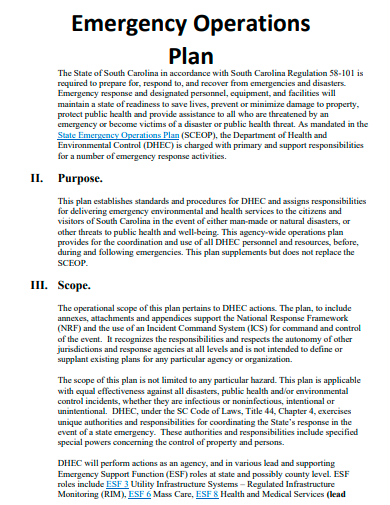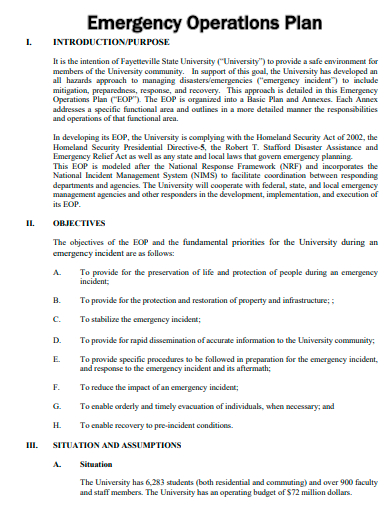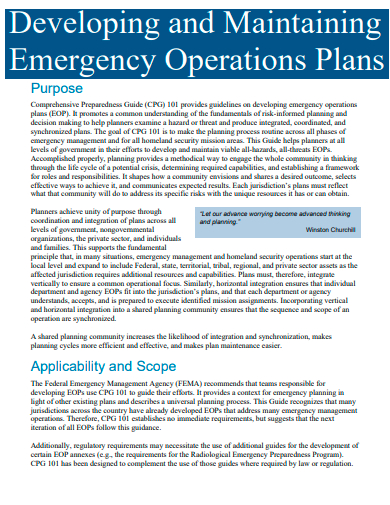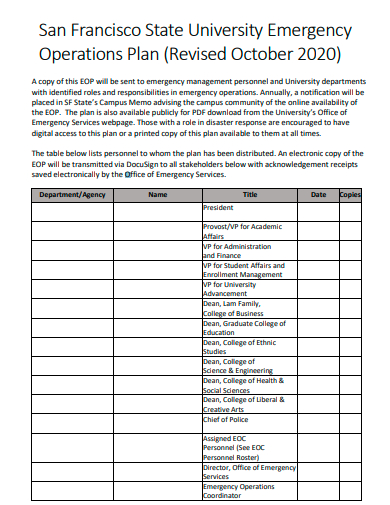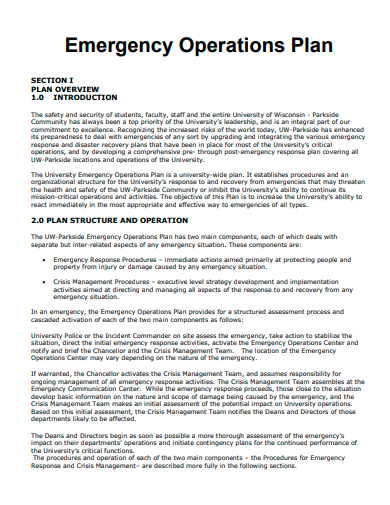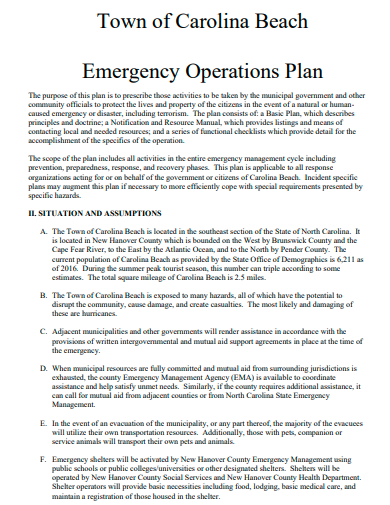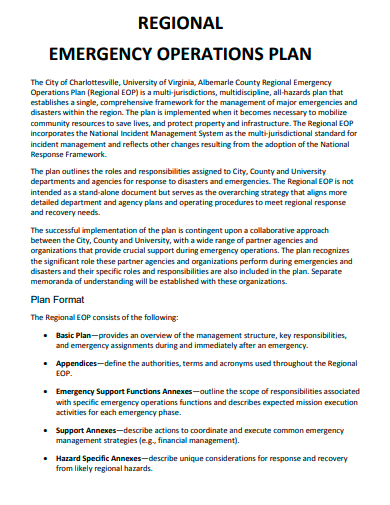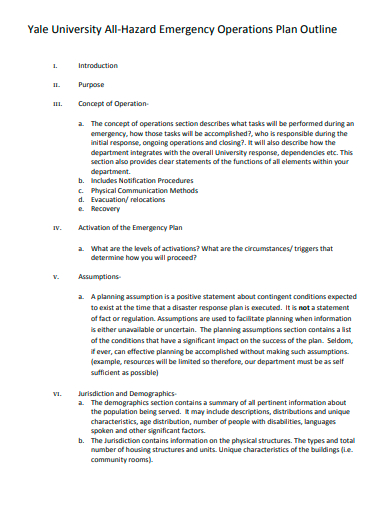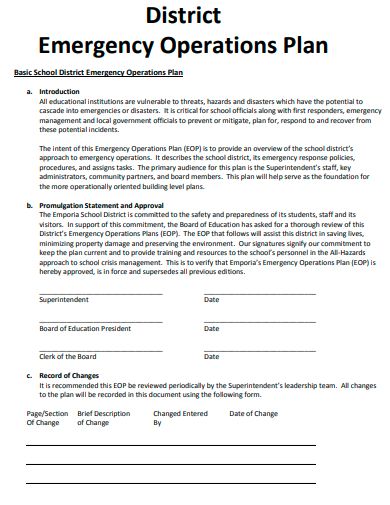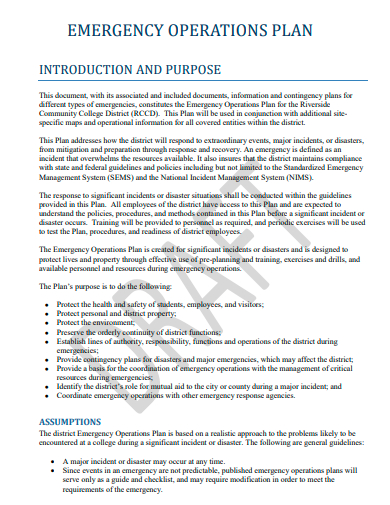Each commercial property needs to have a contingency plan in place, regardless of the nature of the unexpected event that may arise. Given the potentially disastrous outcomes, this endeavor must never be given up under any circumstances. Because workplace accidents, unforeseen occurrences, and activity hazards are all a normal part of our lives, being well-prepared for emergencies can help reduce the severity of any serious loss of life or property that may occur. Because of this, an emergency operation plan should be an essential component of every company business organization. Not only does this help to minimize damage estimate or losses, but it also assists businesses in discovering unrecognized hazardous conditions that would make an emergency worse and figuring out how to get rid of them.
FREE 10+ Emergency Operations Plan Samples
1. Emergency Operations Plan Template
2. Basic Emergency Operations Plan
3. Standard Emergency Operations Plan
4. Developing and Maintaining Emergency Operations Plan
5. University Emergency Operations Plan
6. Emergency Operations Plan Example
7. Beach Emergency Operations Plan
8. Regional Emergency Operations Plan
9. Emergency Operations Plan Outline
10. District Emergency Operations Plan
11. Draft Emergency Operations Plan
What Is an Emergency Operations Plan?
The Emergency Operations Plan (EOP) outlines the organizational structure and procedures that the company will utilize to react to an incident and begin recovering from it. As a result, the EOP is the component of the EMP that deals with reaction and recovery. However, some situations call for careful event planning and execution, despite the fact that IT is quite useful in various emergencies and has its commonalities. In addition, the plan will include a series of protocols that outline how to respond to emergencies on various levels.
How To Make an Emergency Operations Plan?
There is a requirement for management to plan out procedures and predetermine judgments on how to deal with unforeseen occurrences. This is necessary because emergencies occur when we are least expecting them to do so. When designing a company’s emergency action plan, a wide variety of topics and areas can potentially be addressed. Because of this, it is essential to distinguish between the various risks to which your firm is susceptible.
Step 1- Assigning Roles
The assignment of duties and responsibilities is a crucial aspect of any emergency action plan that may be put into place. Every staff member needs to have a certain position that they are responsible for focusing on. They will prevent people from entering potentially hazardous locations and limit entry to the emergency site.
Step 2- Evacuation Procedures
People will need to either evacuate the building as fast as possible or be prepared to navigate to a safer portion of the structure, but this will depend on the nature of the emergency that has occurred. Because every person must know exactly where to go in the case of an emergency, and because this necessitates a level of familiarity with the surrounding area, a floor plan of the facility is required to develop an emergency response plan.
Step 3- Ways To Report Emergencies
Establish protocols for reporting emergencies, whether they result from natural causes or mistakes made by humans. In most incidents, the participation of law enforcement, emergency medical services, and fire and rescue personnel will be required. This responsibility should be delegated to a specific individual, and the emergency action plan should be updated to include all relevant telephone numbers and other contact information in case of a crisis.
Step 4- Employee Training
Your company’s emergency action plan should include training for employees for emergencies, which should ideally take place during employee onboarding. The training should teach participants how to use fire extinguishers, locate exits and escape routes, practice evacuating the building in the event of a fire or other emergency, and cover various other crucial topics.
Why is an evacuation plan so important?
People will need a safe place to go in case of an emergency. With an evacuation plan, people won’t have to split up and run in different directions because they won’t know where to go. Instead, they’ll know where they should go and when they should be there.
What is considered an emergency at work?
Workplace emergencies are unplanned events that could put employees in danger or cause property damage. For example, it might stop or slow down facility operations or cause damage to the building or the environment.
What is a plan for handling an emergency?
This is how the risk to people and the environment is managed. Its goal is to make all hazards, including disasters, less dangerous.
No matter how cautious we are, there is always the potential for accidents, mishaps, and risks. And businesses are not free from such requirements either. Because of this, every business organization needs to set aside some time to sit down and engage in some creative thinking to devise a company emergency action plan that may assist in ensuring the continued success of their company as well as the health and safety of their workforce.
Related Posts
FREE 10+ Home Safety Emergency Plan Samples in MS Word ...
FREE 10+ Safety Emergency Response Plan Samples in MS Word ...
FREE 4+ Warehouse Action Plan Samples [ Emergency, Corrective ...
FREE 10+ Emergency Safety Plan Samples in MS Word Google ...
FREE 10+ Hospital Crisis Communication Plan Samples in MS ...
FREE 9+ Crisis Plan Samples in PDF MS Word
FREE 13+ Crisis Management Plan Samples in PDF MS Word
FREE 10+ University Crisis Communication Plan Samples in MS ...
FREE 10+ Business Emergency Action Plan Samples in MS Word ...
FREE 9+ Contingency Plan Samples in MS Word PDF
FREE 4+ Charity Disaster Recovery Plan Samples & Templates in ...
FREE 9+ Sample Emergency Response Plan Templates in PDF ...
FREE 10+ Church Emergency Action Plan Samples in MS Word ...
FREE 10+ Security Contingency Plan Samples in PDF MS Word ...
FREE 10+ Child Care Risk Management Plan Samples in PDF MS ...

